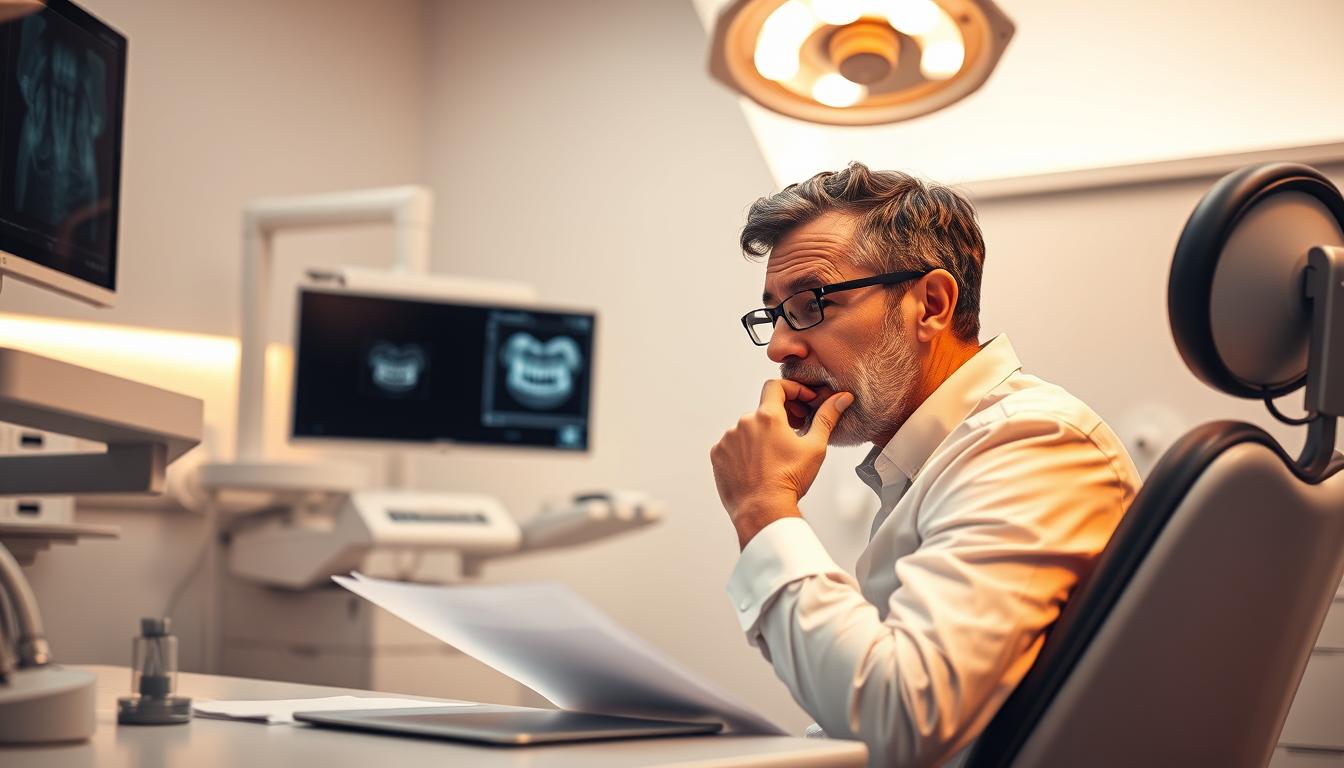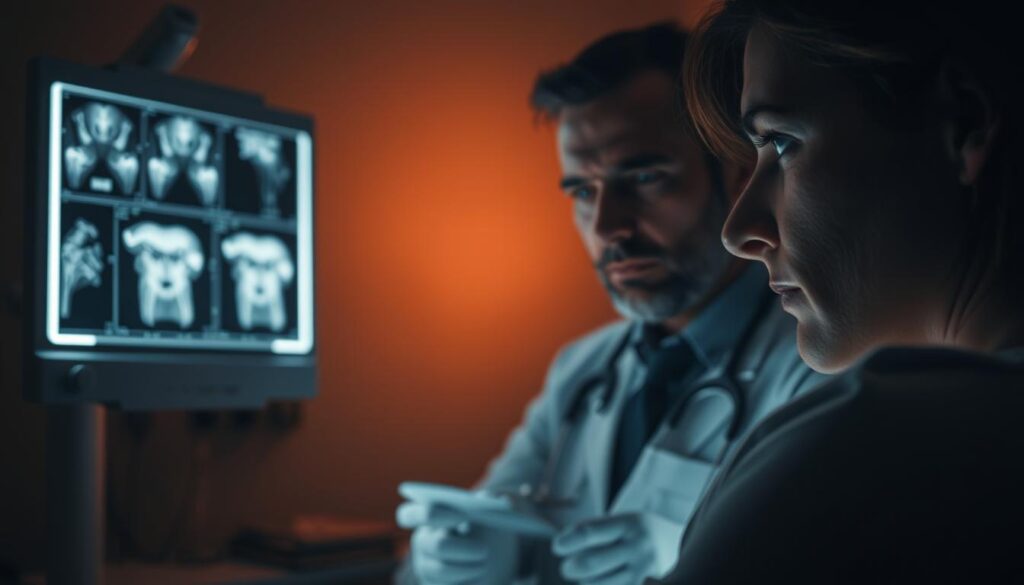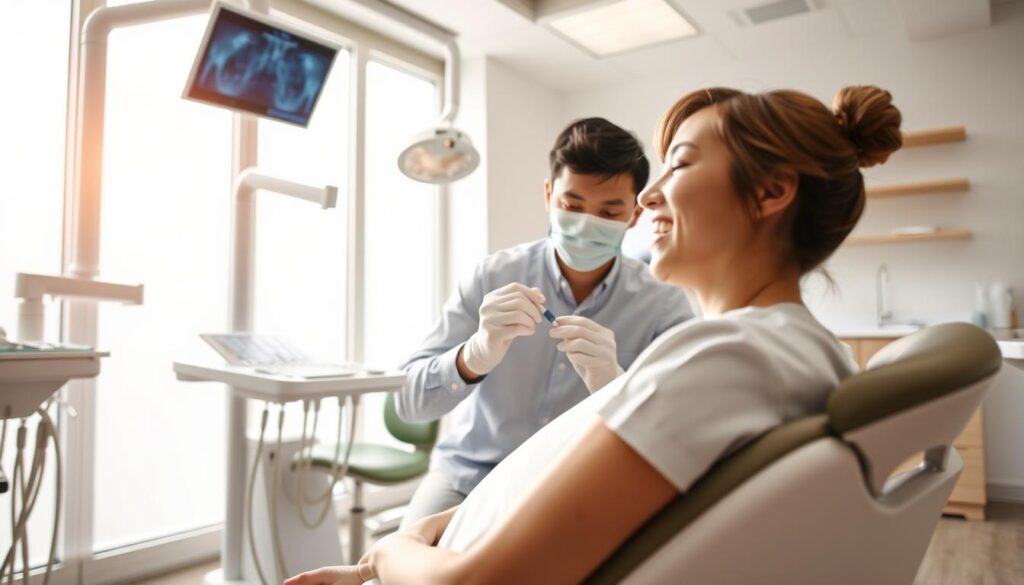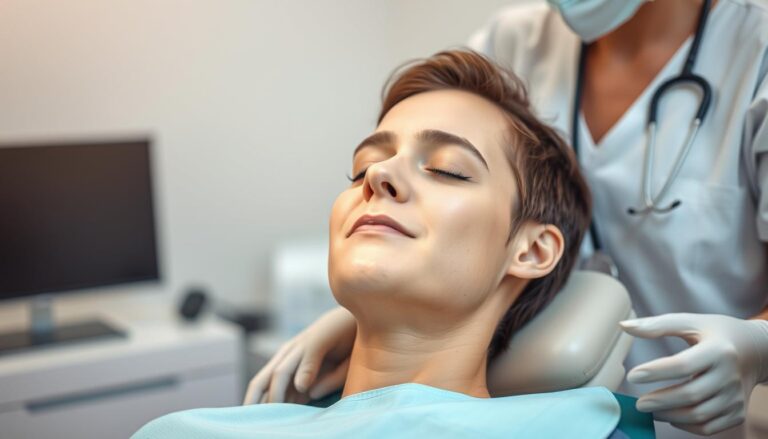Can I Refuse X-rays and Still Get My Teeth Cleaned?

In the United States, dentists usually want you to get check-up X-rays every 12 to 18 months. They suggest a full mouth series every 3 to 5 years after you turn 18. Following these guidelines from the American Dental Association helps provide total oral care. Yet, some patients ask: “Can I refuse X-rays and still get my teeth cleaned?” It’s not simple. Most dentists believe in doing a full check-up, including X-rays, before cleanings. This helps prevent any chance of missing something important and keeps patients safe.
Many patients worry about the radiation from dental X-rays. They compare it to radiation we come across every day. Because of these worries, some wonder if they can skip the X-rays. This is especially true for those concerned about radiation or if they’re pregnant. But, not getting X-rays might make dentists hesitant to proceed with certain treatments. They want to ensure they’re doing everything right for the patient’s overall health.
Thinking over whether to refuse X-rays before a teeth cleaning is important. It’s key to know why these rules exist and what effect they have on dental care. This article looks into why you might need X-rays or choose not to have them before cleaning your teeth. It helps patients understand their choices when it comes to their dental well-being.
Key Takeaways
- Understand the industry standards regarding the frequency of dental X-rays as per American Dental Association guidelines.
- Recognize the relationship between diagnostic X-rays and the quality of dental care received.
- Explore the potential implications of refusing X-rays on both dental treatments and patient safety.
- Comprehend the minimal levels of radiation exposure from dental X-rays compared to everyday environmental sources.
- Learn the nuances of patient autonomy with respect to medical imaging in dental practice.
Understanding Dental X-rays and Their Importance
Dental X-rays are key in modern dentistry. They reveal details not seen during a regular exam. They are vital for assessing oral health and guiding treatment plans.
What Are Dental X-rays?
Dental X-rays are tools that let dentists see hidden parts of the mouth. This includes tooth roots, jaw bones, and the structure of the face. They are essential for finding problems like impacted teeth, decay, and damage to the jawbone that can’t be seen in a normal exam.
Types of Dental X-rays
There are many types of dental X-rays, each with a special role in oral health. The most common include:
- Intraoral X-rays, which are very detailed and important for spotting cavities and checking the health of teeth and bones.
- Panoramic X-rays, that show the whole mouth in one image. They are great for planning treatments and following growth.
- Cephalometric projections, that show one side of the head. These help dentists see how teeth relate to the jaw and facial profile.
Why Are X-rays Recommended?
Dental X-rays are crucial for finding and diagnosing dental issues early. They let dentists see places between teeth and below the gums that are invisible without X-rays. Catching problems early with X-rays can stop bigger, costlier treatments later. Knowing the importance of dental X-rays is key for keeping teeth healthy over time. This is something often missed when thinking about dental care without X-rays.
Although X-rays are very useful, some people worry about radiation. If you’re concerned, talk to your dentist. They can discuss alternatives and make a dental care plan that meets your needs.
In the end, whether using regular X-rays or looking at alternatives for dental cleanings, the goal is the same. We aim to give thorough care that looks after your overall dental health.
The Risks of Refusing X-rays
Thinking about skipping X-rays at your dental visits? It’s critical to fully grasp the risks this choice involves. Not getting X-rays when your dentist suggests them can greatly affect the quality and results of your dental care.
Potential For Undetected Issues
Avoiding X-rays can lead to missed dental problems. Without them, dentists might not catch cavities between teeth, infections in tooth roots, or bone loss from gum disease. These hidden issues can get worse without warning, making treatment more complex and costly later on.
Impact on Treatment Planning
Without X-ray images, dentists can’t plan as accurately. Opting out of X-rays might seem good initially but leaves gaps in your dental records. This lack of info stops dentists from taking steps that prevent future problems and keep your mouth healthy.

The chart below shows the differences between using X-rays and not using them in dental care. It points out how not having X-rays can lead to overlooked serious dental issues. These oversights can deeply affect a patient’s oral health and the treatments they might need.
| Aspect of Dental Care | With X-Ray Screening | Without X-Ray Screening |
|---|---|---|
| Detection of Interdental Cavities | High probability | Low probability |
| Identification of Root Infections | Possible before symptoms appear | Typically diagnosed after symptom onset |
| Bone Health Assessment | Detailed imaging provided | Not possible |
| Accuracy of Treatment Planning | High accuracy and precision | Compromised |
| Preventative Measures Implemented | Effective and timely | Limited and possibly delayed |
To wrap things up, while skipping dental X-rays might seem like a good idea to some, the potential dangers are significant. It’s a choice that demands careful thought, especially when you consider the benefits of thorough dental reviews with X-ray tech.
Legal and Ethical Considerations
The use of diagnostic X-rays in dentistry brings together law and ethics. It’s vital for both dental professionals and patients to understand the legal considerations dental X-rays involve. This helps manage consent and refusal correctly.
Patient rights in refusing X-rays are key to healthcare choice. Patients should know how crucial X-rays are for spotting dental issues. Yet, they can say no to these procedures. Clear communication and keeping records are essential to protect both sides.
Denying advised treatments, like X-rays, is tricky ethically. Dentists have to respect a patient’s choice but also meet their care duties. They mustn’t seem careless if they agree to a patient’s refusal.
Choosing treatment without X-rays needs clear talks about the dangers of missed diagnoses. It guards legally and is ethically right. It lets patients make informed choices, knowing all potential outcomes.
- Discussing the limitations of visual and physical exams without X-rays
- Highlighting the examples of conditions that may go undiagnosed
- Ensuring all advice and warnings are documented
Here, we dive into why informed consent is critical:
| Aspect of Consent | Importance |
|---|---|
| Understanding of Procedure | Patient knows what the X-ray does and its purpose. |
| Potential Risks of Refusal | Patient understands the risks of not getting X-rays. |
| Documentation | Consent or refusal gets recorded, keeping both sides safe. |
Informed consent is more than a legal step. It’s a process where patient choice is valued, and dentists perform their duty to inform and advise.
In sum, patients can refuse X-rays. But, dental providers must carefully handle the legal considerations dental X-rays present. They must make sure refusal isn’t due to wrong information and that patients understand all risks.
Communication with Your Dentist
When you’re worried about dental X-rays, talk to your dentist. Many people worry about X-rays because of health, discomfort, or cost. By discussing X-ray concerns with the dentist, they can make a plan that suits you best. This way, you feel safe and know what’s happening in your dental care.

Looking at alternatives to traditional dental X-rays is something many dentists do to help you feel more comfortable. With new technology, like digital X-rays, the process is safer and less scary. These options reduce radiation and make the experience better for those who fear regular X-rays. Here are some alternatives:
- Digital X-rays: Less radiation than traditional X-rays and provide higher quality images for better diagnosis.
- Intraoral cameras: Allow for a more interactive discussion as patients can see the inside of their mouth in real-time on a screen.
- 3D imaging: Used for more complex cases, providing comprehensive views that can eliminate the need for multiple X-rays.
Dentists often adjust their methods or how often they do X-rays to make sure you’re comfortable. That’s why discussing X-ray concerns with your dentist is good. It lowers your worry and builds trust. This makes your dental care feel more customized to you.
Dental Cleanings Explained
Dental cleanings are key for keeping your smile looking great and your mouth healthy. They help prevent problems like periodontitis and cavities. Dental pros get rid of plaque and tartar that your toothbrush can’t. They start with a check of your mouth, then clean around your gums with special tools. Lastly, they polish your teeth to remove surface stains.

Choosing a cleaning without X-rays can still be very helpful. It’s good for those who want to avoid X-rays for health reasons. X-ray free teeth cleaning lowers the risk of gum disease and tooth decay. It also makes your breath fresh and your smile bright.
- Reduction of periodontal disease risk by removing hidden plaque and tartar.
- Prevention of cavities by cleaning hard-to-reach areas that daily brushing and flossing might miss.
- Early detection of potential oral health issues through physical exams and professional oversight.
Talking to your dentist about your health needs is crucial, especially if you avoid X-rays. This choice might make it harder for your dentist to spot all issues. Keeping an open conversation about the benefits of dental cleaning no X-ray is important. This ensures you and your dentist agree on your treatment plan.
The Relationship Between X-rays and Cleanings
Looking into how dental cleanings and X-rays work together gives us deep insights. X-rays are very important as they show details we can’t see just by looking. These include areas between teeth, under the gums, and under fillings. With these images, dentists can spot problems that a simple cleaning might miss.
Thinking about dental hygiene without X-rays? It’s key to know that, while cleanings do a great job, not having X-rays might mean we miss some dental issues. So, X-ray free dental cleaning options might not catch everything going on with our oral health.
Let’s get into the details:
- How X-rays Complement Cleanings: X-rays help give a full picture of our oral health, pointing out problems not visible during a check-up.
- Are Cleanings Safe Without X-rays? Cleanings without X-rays are still safe and help our oral health. But, they might not find all potential problems since they don’t offer a complete view.
To get the best dental care, using both X-rays and cleanings is suggested. It helps catch problems early. This approach keeps our dental care top-notch, helping prevent bigger issues later.
Making Informed Choices
When thinking about skipping X-rays during teeth cleaning, it’s smart to look at your dental past. Check your old dental records for patterns like cavities or gum disease. It’s also key to think about your overall health and habits, like smoking.
Knowing the pros and cons helps you make wise decisions in dental care. Find out more about dental problems that could pop up if you skip regular X-rays. This info is crucial for understanding why X-rays might be needed to stop dental issues before they start.

At first, not getting dental X-rays might seem like a good idea. But, think about the future. Missing early warning signs could mean needing more serious treatments later. Talk with your dentist about the pros and cons to make choices that fit your health and likes.
Choosing whether to get dental X-rays should be based on good knowledge and advice from dentists. Look at your health and dental past before deciding. Being well-informed lets you handle your dental care with confidence and care.
Alternatives to Traditional X-rays
In the world of dental check-ups, traditional X-rays have been very important. But now, we have many dental X-ray alternatives. These new options help us meet different needs and likes of patients.
Digital X-rays are a big step forward. They are special because they use very little radiation. They also give instant results. This makes them a great choice for modern dentistry, which focuses on being safe and easy for patients.
But there are more choices than just digital X-rays. Tools like intraoral cameras and 3D imaging are other ways doctors can look inside your mouth without causing discomfort. They may not give all the details like X-rays do. Yet, they still provide important information for checking dental health.
To really understand these new options, we need to look at how they work in real life. Things like how easy they are to get, how much they cost, and what the patient needs are important to think about.
So, when we talk about these alternatives, we should carefully think about their benefits. Our main aim is to make sure patients get the best care and feel comfortable.
Insurance and Cost Considerations
Understanding the interaction between dental treatment costs and dental insurance and X-rays is important. Dental insurance often covers X-rays during routine checks. Skipping X-rays can affect your insurance benefits.
Comparing the costs of dental cleaning with and without X-rays is crucial. Avoiding X-rays might seem to save money at first. However, not spotting early issues can lead to higher costs later. Below is a detailed cost comparison:
| Cleaning Type | Initial Cost | Projected Long-term Cost due to Undetected Issues |
|---|---|---|
| Cleaning with X-rays | $120 | $120 |
| X-ray Free Cleaning | $80 | $300 |
Avoiding X-rays can lower costs now but may increase dental treatment costs in the future. Investing in diagnostic X-rays upfront can save money on treatments later. It’s a smart way to manage dental health expenses.

To fully understand your dental insurance coverage, talking to your provider is wise. They can advise if delaying X-rays is an option. You can find more about dental insurance and X-rays on VisoDent’s blog: Dental Check-ups and Cleanings – What to.
In conclusion, think carefully before refusing X-rays to save on dental costs. Consider how it could impact future costs and insurance coverage. Making a well-informed choice is key for your financial and dental health.
Preparing for Your Dental Appointment
Getting ready for a dental visit is key, especially with choices about X-rays on the line. Good dental appointment preparation helps ease worries. It also makes you ready to have informed talks with your dentist.
To get ready for a dental cleaning, you should know which questions to ask and which papers to bring. If you’re unsure about how often to get dental check-ups, there are in-depth guides at how often dental cleanings and exams are suggested.
Questions to Ask Your Dentist
- What are the main aims of today’s cleaning?
- If X-rays are suggested, what other options do we have?
- How does my medical history affect planned dental treatments?
What to Bring to Your Appointment
- Your dental insurance card and a form of ID.
- A list of any medicines you’re currently taking.
- Any dental records and X-rays from past visits.
These questions for your dentist and the list of items to bring make your visit more useful. Having all needed documents and info ready truly helps in getting dental care that’s tailored just for you.
Maintaining Oral Health Without X-rays
X-rays are common in checking teeth, but there’s a way to keep teeth healthy without them. It means focusing more on oral health without X-rays. This includes dental hygiene home care and visiting the dentist often.
Taking care of your teeth at home is key, especially without regular X-rays. Brushing every day, flossing right, and using tools like water flossers and mouthwash help a lot. They fight plaque and stop tooth diseases.
- Brush twice a day with fluoride toothpaste.
- Floss daily to get rid of plaque between teeth.
- Use an antimicrobial mouthwash to cut down bacteria and gum disease.
Even if you skip X-rays, seeing your dentist regularly is vital. Dentists can spot problems early, even without X-ray images. They check your teeth closely, keep tabs on gum health, and teach you about tooth care.
| Evaluation Component | Purpose | Frequency |
|---|---|---|
| Visual Inspection | To look for signs of cavities, gum disease, and other issues. | Every visit |
| Gum Health Assessment | To check gum health and look for disease signs. | Every visit |
| Professional Teeth Cleaning | To get rid of tartar that brushing and flossing can’t remove. | Every 6 months |
To sum up, dental hygiene home care is the base for oral health without X-rays. Regular dental evaluations play a big part too. They help catch and treat dental problems early.
Conclusion: Weighing Your Options
In the world of dental care, choosing whether or not to get X-rays can be big. This choice shouldn’t be made without thinking it through. Dental X-rays are essential for dentists to see everything about your oral health.
They help find problems that aren’t visible to the naked eye. Knowing this can help stop bigger teeth issues later on. X-rays are key in preventing serious dental problems.
Dental X-rays do more than just spot issues. They help dentists take care of your teeth before small problems get worse. But, not everyone might need them the same way.
The advice of doctors is crucial here. To help make the right choice, looking into other dental options might be helpful. It’s about matching your needs with the best dental care.
As our discussion ends, remember to talk with your dentist and also, do your own research. Knowledge lets you make better decisions for your teeth. The right choice balances your comfort, safety, and the advantages of dental tech.
X-rays are important in this balance. Remember, taking care of your mouth is part of taking care of your whole body. Our goal is to improve health care and help everyone.


